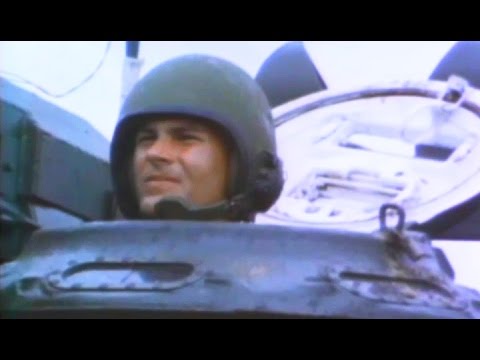Corps of Engineers in Vietnam: “They Clear the Way” 1968 US Army; The Big Picture TV-732
more at
“RECOUNTS THE STORY OF THE ARMY CORPS OF ENGINEERS AND THEIR MISSION IN VIETNAM TO BUILD BRIDGES, AIRFIELDS, AND ROADS THAT BRING MOBILITY TO THE COMBAT FORCES.”
Public domain film from the US National Archives, slightly cropped to remove uneven edges, with the aspect ratio corrected, and mild video noise reduction applied.
The soundtrack was also processed with volume normalization, noise reduction, clipping reduction, and/or equalization (the resulting sound, though not perfect, is far less noisy than the original).
The United States Army Corps of Engineers (USACE, also sometimes shortened to CoE is a U.S. federal agency under the Department of Defense and a major Army command made up of some 37,000 civilian and military personnel, making it one of the world’s largest public engineering, design, and construction management agencies. Although generally associated with dams, canals and flood protection in the United States, USACE is involved in a wide range of public works throughout the world. The Corps of Engineers provides outdoor recreation opportunities to the public, and provides 24% of U.S. hydropower capacity.
The corps’ mission is to “Deliver vital public and military engineering services; partnering in peace and war to strengthen our Nation’s security, energize the economy and reduce risks from disasters.”
Their most visible missions include:
– Planning, designing, building, and operating locks and dams. Other civil engineering projects include flood control, beach nourishment, and dredging for waterway navigation.
– Design and construction of flood protection systems through various federal mandates.
– Design and construction management of military facilities for the Army, Air Force, Army Reserve and Air Force Reserve and other Defense and Federal agencies.
– Environmental regulation and ecosystem restoration.
The corps’ vision is “Engineering solutions for our Nation’s toughest challenges.”…
Early history
The history of United States Army Corps of Engineers can be traced back to 16 June 1775, when the Continental Congress organized an army with a chief engineer and two assistants. Colonel Richard Gridley became General George Washington’s first chief engineer; however, it was not until 1779 that Congress created a separate Corps of Engineers. One of its first tasks was to build fortifications near Boston at Bunker Hill. The first corps was mostly composed of French subjects who had been hired by General Washington from the service of Louis XVI.
The Corps of Engineers, as it is known today, came into existence on 16 March 1802, when President Thomas Jefferson was authorized to “organize and establish a Corps of Engineers … that the said corps … shall be stationed at West Point in the State of New York and shall constitute a military academy.” Until 1866, the superintendent of the United States Military Academy was always an engineer officer. During the first half of the 19th century, West Point was the major and, for a while, the only engineering school in the country…
During World War II, the Army Corps of Engineers in the European Theater of Operations was responsible for building countless bridges,including the first and longest floating tactical bridge across the Rhine at Remagen, and building or maintaining roads vital to the Allied advance across Europe into the heart of Germany. In the Pacific theater, the Pioneer troops were formed, a hand-selected unit of volunteer Army combat engineers trained in jungle warfare, knife fighting, and unarmed jujitsu (hand-to-hand combat) techniques. Working in camouflage, the Pioneers cleared jungle and prepared routes of advance and established bridgeheads for the infantry as well as demolishing enemy installations.
Five commanding generals (chiefs of staff after the 1903 reorganization) of the United States Army held engineer commissions early in their careers. All transferred to other branches before rising to the top. They were Alexander Macomb, George B. McClellan, Henry W. Halleck, Douglas MacArthur, and Maxwell D. Taylor…

